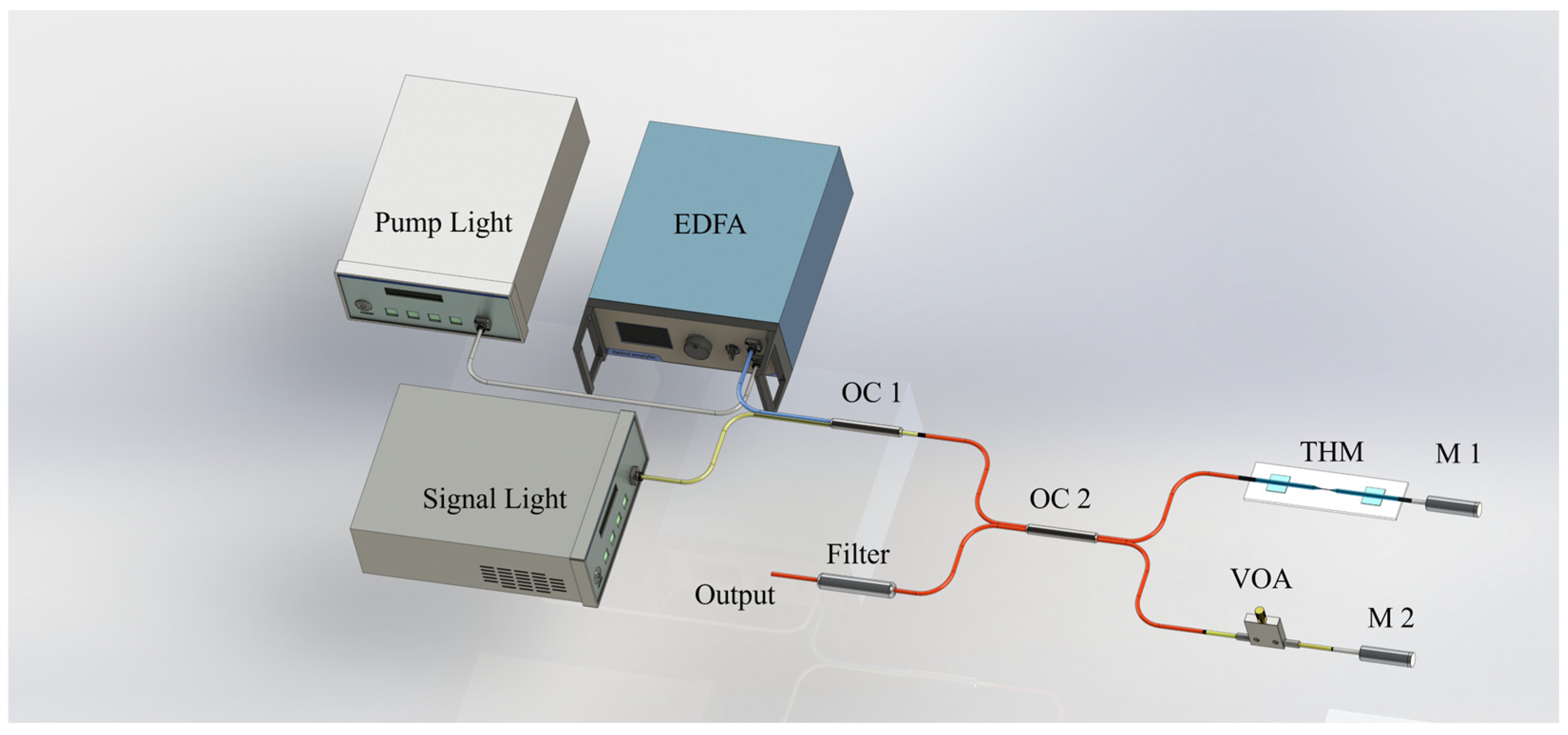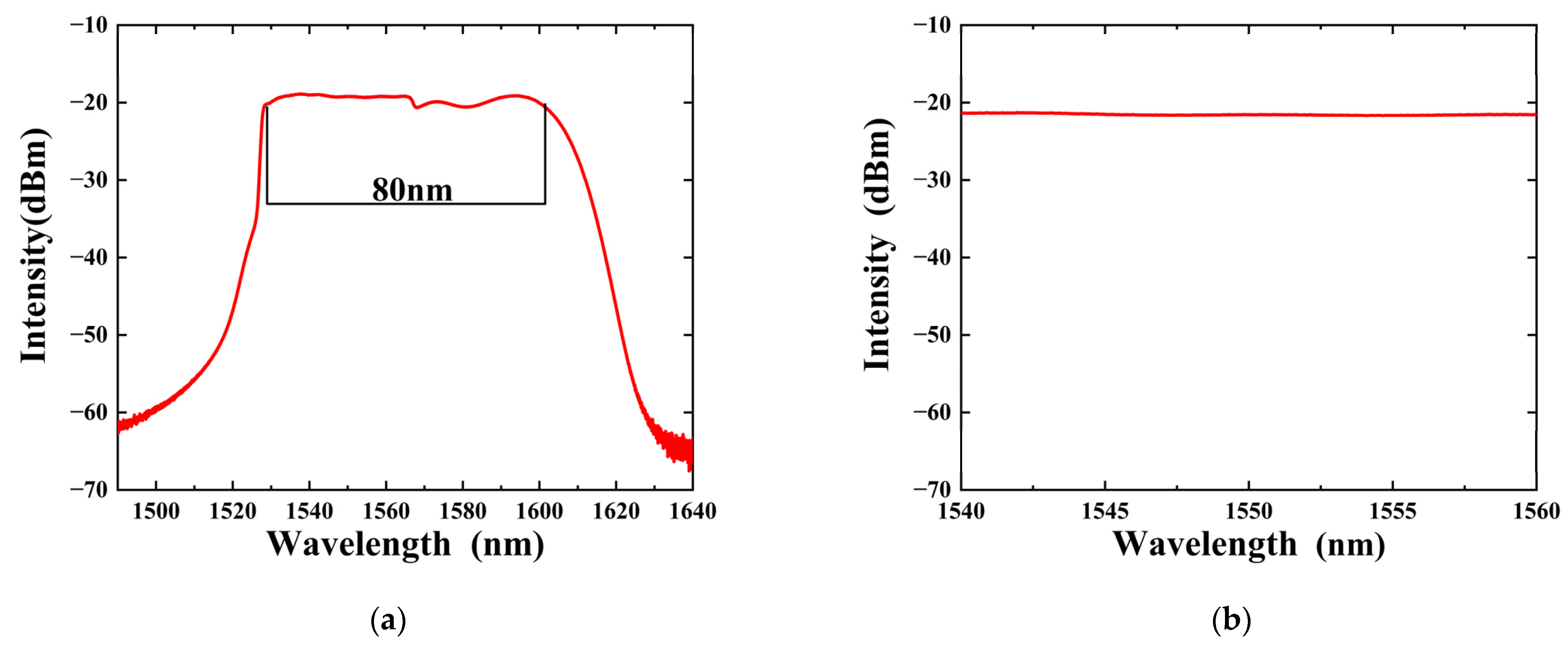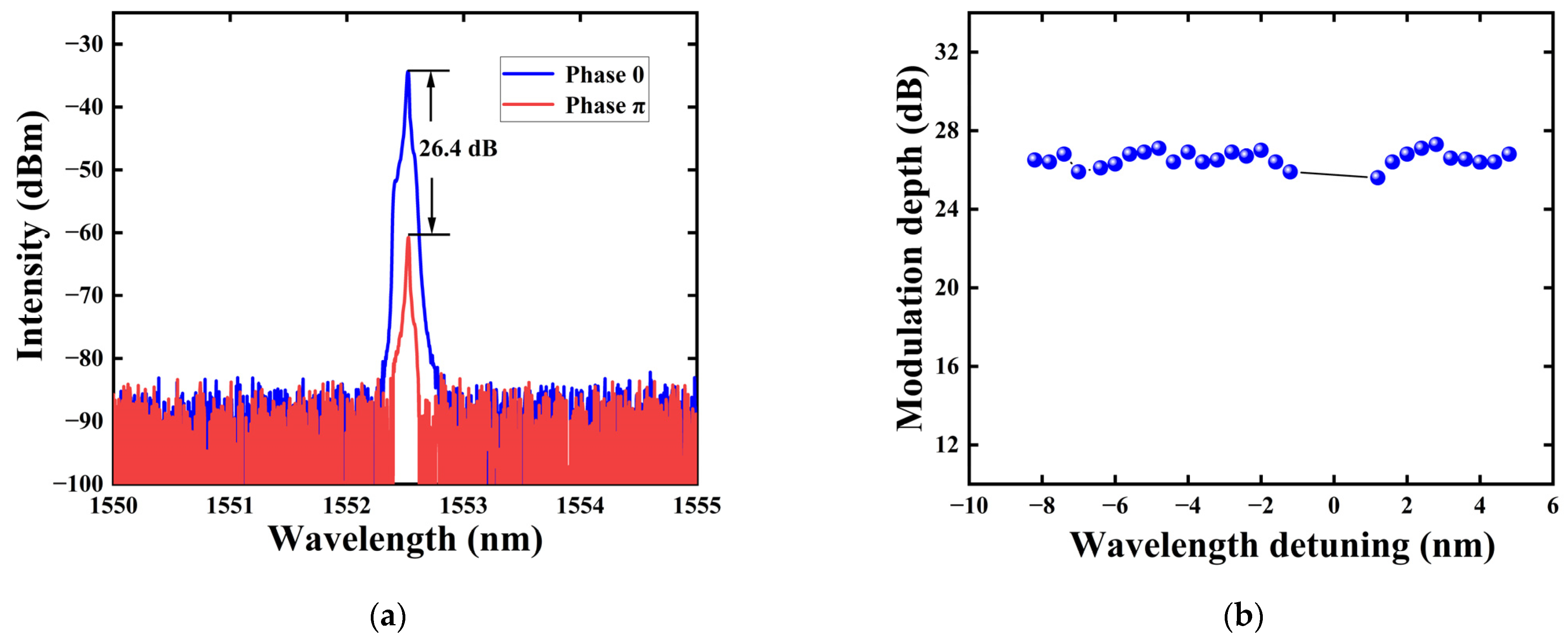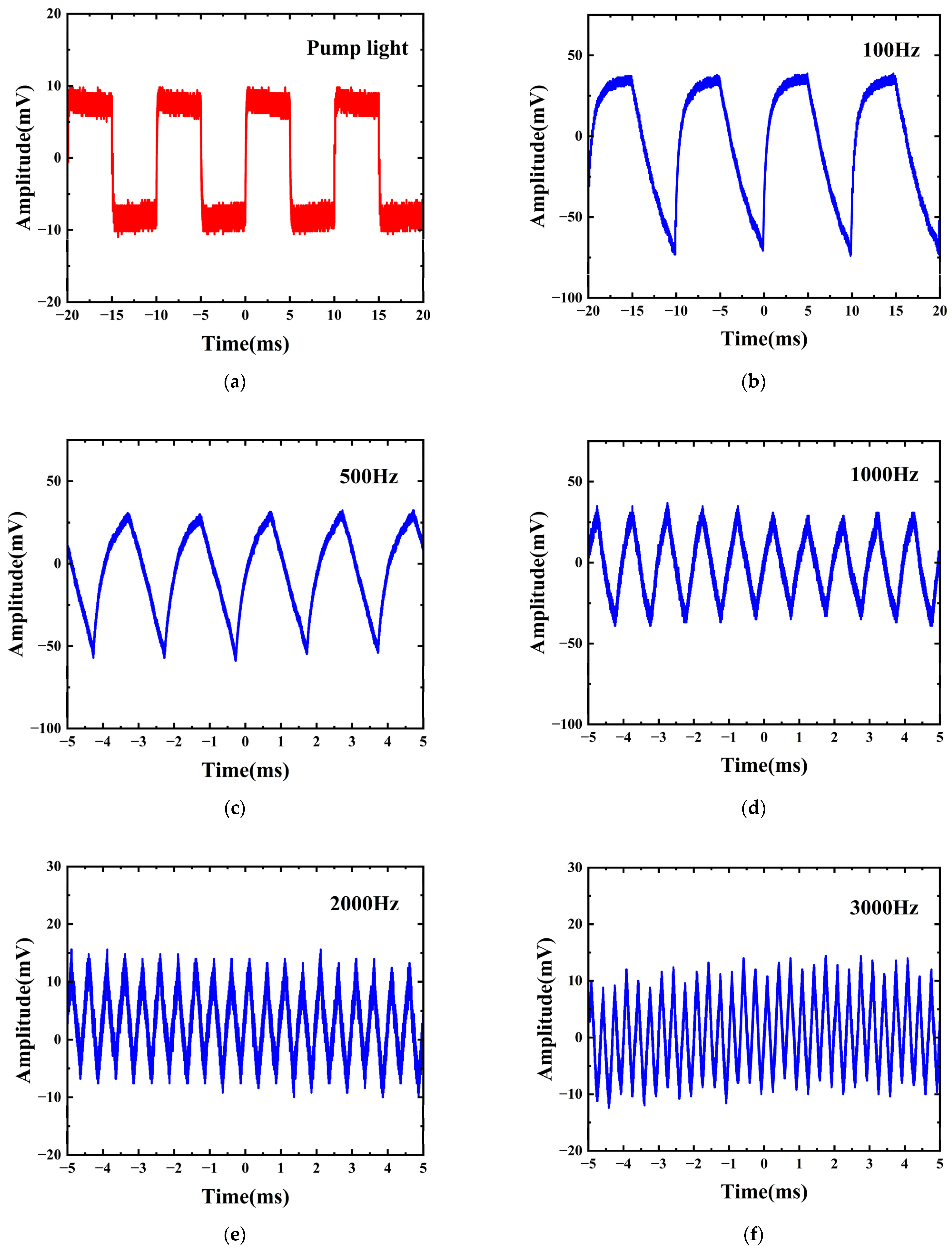Novel Optical Modulator Photonic Device Based on TiN/Ti3C2 Heterojunction
Abstract
1. Introduction
2. Experimental Principle and Setup
3. Results and Discussion
3.1. Phase Shift Experiment
3.2. Modulation Experiment
4. Conclusions
Author Contributions
Funding
Institutional Review Board Statement
Informed Consent Statement
Data Availability Statement
Conflicts of Interest
References
- Yuan, B.; Cai, H. Research on The Current Situation and Development Trend of Optical Fiber Communication Technology. J. Phys. Conf. Ser. 2021, 1873, 012013. [Google Scholar] [CrossRef]
- Ullah, R.; Ullah, S.; Khan, J.; Al-Atawi, A.A.; Alwageed, H.S. Efficient Optical Fiber Communication in the Metro Access Domain Based on an Optical Multicarrier Source. Microw. Opt. Technol. Lett. 2024, 66, e33883. [Google Scholar] [CrossRef]
- Willner, A.E.; Khaleghi, S.; Chitgarha, M.R.; Yilmaz, O.F. All-Optical Signal Processing. J. Lightwave Technol. 2014, 32, 660–680. [Google Scholar] [CrossRef]
- Liu, Z.; Xu, T.; Qi, J.; Uduagbomen, J.; Zhao, J.; Liu, T. Achievable Information Rate Optimization in C-Band Optical Fiber Communication System. Front. Optoelectron. 2023, 16, 17. [Google Scholar] [CrossRef] [PubMed]
- Wang, K.; Liu, Q.; Wang, Z.; Song, Y.; Huang, H.; Fan, N.; Wang, Y.; Zhang, B. TiN/Ti3C2 Heterojunction-Based Photonic Device for Optical Kerr Switch. RSC Adv. 2023, 13, 24649–24655. [Google Scholar] [CrossRef] [PubMed]
- Wang, F.; Qu, Y.; Zhang, H.; Lin, S.; Han, X.; Wei, Y.; Zhao, Z.; Zhang, Y. All-Fiber All-Optical Phase Controller Based on F-P Interferometer and Er/Yb Co-Doped Fiber. Opt. Fiber Technol. 2023, 81, 103496. [Google Scholar] [CrossRef]
- Chan, E.H.W.; Minasian, R.A. All-Optical Frequency Shifter Based on Stimulated Brillouin Scattering in an Optical Fiber. IEEE Photonics J. 2014, 6, 1–10. [Google Scholar] [CrossRef]
- Ren, A.; Feng, M.; Song, F.; Ren, Y.; Yang, S.; Yang, Z.; Li, Y.; Liu, Z.; Tian, J. Actively Q-Switched Ytterbium-Doped Fiber Laser by an All-Optical Q-Switcher Based on Graphene Saturable Absorber. Opt. Express 2015, 23, 21490–21496. [Google Scholar] [CrossRef] [PubMed]
- Yun, H.-G.; Lee, S.H.; Lee, M.H.; Kim, K.H. An Actively Q -Switched Single-Longitudinal-Mode Fiber Laser with an Optically Pumped Saturable Absorber. Laser Phys. 2013, 23, 095107. [Google Scholar] [CrossRef]
- Choudhary, R.; Kumar, A. All-Optical Half Adder and Subtractor Circuits Using Cross-Phase Modulation Based Switching Effect in the Phase-Shifted Fiber Bragg Gratings. Opt. Quantum Electron. 2023, 55, 330. [Google Scholar] [CrossRef]
- Yi, D.; Huang, Z.; Fu, W.; Geng, Y.; Liu, F.; Li, X. Ultra-Sensitive All-Optical Phase Modulation Based on a Fiber Optic Interferometer Combined with Ti3C2Tx MXene-Incorporated PDMS. Opt. Lett. 2023, 48, 4456–4459. [Google Scholar] [CrossRef] [PubMed]
- Wang, C.; Zhang, M.; Stern, B.; Lipson, M.; Lončar, M. Nanophotonic Lithium Niobate Electro-Optic Modulators. Opt. Express 2018, 26, 1547–1555. [Google Scholar] [CrossRef] [PubMed]
- Mesleh, R.; AL-Olaimat, A. Acousto-Optical Modulators for Free Space Optical Wireless Communication Systems. J. Opt. Commun. Netw. 2018, 10, 515–522. [Google Scholar] [CrossRef]
- Cai, L.; Mahmoud, A.; Khan, M.; Mahmoud, M.; Mukherjee, T.; Bain, J.; Piazza, G. Acousto-Optical Modulation of Thin Film Lithium Niobate Waveguide Devices. Photon. Res. 2019, 7, 1003–1013. [Google Scholar] [CrossRef]
- Bo, Y.; Guan, C.; Chu, R.; Cheng, T.; Xu, L.; Liu, L.; Yang, J.; Shi, J.; Wang, P.; Yang, J.; et al. Compact All-Fiber Thermo-Optic Modulator Based on a Michelson Interferometer Coated with NaNdF4 Nanoparticles. Opt. Express 2021, 29, 6854–6862. [Google Scholar] [CrossRef] [PubMed]
- Wang, C.; Chen, Q.; Chen, H.; Liu, J.; Song, Y.; Liu, J.; Li, D.; Ge, Y.; Gong, Y.; Zhang, Y.; et al. Boron Quantum Dots All-Optical Modulator Based on Efficient Photothermal Effect. Opto-Electron. Adv. 2021, 4, 200032. [Google Scholar] [CrossRef]
- Mendez-Astudillo, M.; Okamoto, M.; Ito, Y.; Kita, T. Compact Thermo-Optic MZI Switch in Silicon-on-Insulator Using Direct Carrier Injection. Opt. Express 2019, 27, 899–906. [Google Scholar] [CrossRef] [PubMed]
- Song, J.; Fang, Q.; Tao, S.H.; Liow, T.Y.; Yu, M.B.; Lo, G.Q.; Kwong, D.L. Fast and Low Power Michelson Interferometer Thermo-Optical Switch on SOI. Opt. Express 2008, 16, 15304–15311. [Google Scholar] [CrossRef] [PubMed]
- Gan, X.; Zhao, C.; Wang, Y.; Mao, D.; Fang, L.; Han, L.; Zhao, J. Graphene-Assisted All-Fiber Phase Shifter and Switching. Optica 2015, 2, 468–471. [Google Scholar] [CrossRef]
- Wu, K.; Guo, C.; Wang, H.; Zhang, X.; Wang, J.; Chen, J. All-Optical Phase Shifter and Switch near 1550nm Using Tungsten Disulfide (WS2) Deposited Tapered Fiber. Opt. Express 2017, 25, 17639–17649. [Google Scholar] [CrossRef]
- Wang, Y.; Zhang, F.; Tang, X.; Chen, X.; Chen, Y.; Huang, W.; Liang, Z.; Wu, L.; Ge, Y.; Song, Y.; et al. All-Optical Phosphorene Phase Modulator with Enhanced Stability Under Ambient Conditions. Laser Photonics Rev. 2018, 12, 1800016. [Google Scholar] [CrossRef]
- Yang, S.; Liu, D.; Tan, Z.; Liu, K.; Zhu, Z.; Qin, S. CMOS-Compatible WS2-Based All-Optical Modulator. ACS Photonics 2018, 5, 342–346. [Google Scholar] [CrossRef]
- Srivastava, Y.K.; Chaturvedi, A.; Manjappa, M.; Kumar, A.; Dayal, G.; Kloc, C.; Singh, R. MoS2 for Ultrafast All-Optical Switching and Modulation of THz Fano Metaphotonic Devices. Adv. Opt. Mater. 2017, 5, 1700762. [Google Scholar] [CrossRef]
- Chen, J.; Zheng, B.; Shao, G.; Ge, S.; Xu, F.; Lu, Y. An All-Optical Modulator Based on a Stereo Graphene–Microfiber Structure. Light: Sci. Appl. 2015, 4, e360. [Google Scholar] [CrossRef]
- Yang, X.; Long, Q.; Liu, Z.; Zhang, Y.; Yang, J.; Kong, D.; Yuan, L.; Oh, K. Microfiber Interferometer Integrated with Au Nanorods for an All-Fiber Phase Shifter and Switch. Opt. Lett. 2019, 44, 1092–1095. [Google Scholar] [CrossRef] [PubMed]
- Luo, M.; Yang, X.; Teng, P.; Liu, Z.; Kong, D.; Zhang, J.; Yang, J.; Tian, F.; Gao, D.; Li, Z.; et al. All-Fiber Phase Shifter Based on Hollow Fiber Interferometer Integrated with Au Nanorods. Sens. Actuators A Phys. 2020, 301, 111750. [Google Scholar] [CrossRef]
- Tang, R.; Xiong, S.; Gong, D.; Deng, Y.; Wang, Y.; Su, L.; Ding, C.; Yang, L.; Liao, C. Ti3C2 2D MXene: Recent Progress and Perspectives in Photocatalysis. ACS Appl. Mater. Interfaces 2020, 12, 56663–56680. [Google Scholar] [CrossRef] [PubMed]
- Wang, H.-W.; Naguib, M.; Page, K.; Wesolowski, D.J.; Gogotsi, Y. Resolving the Structure of Ti3C2Tx MXenes through Multilevel Structural Modeling of the Atomic Pair Distribution Function. Chem. Mater. 2016, 28, 349–359. [Google Scholar] [CrossRef]
- Xia, X.; Ma, C.; Chen, H.; Khan, K.; Tateen, A.K.; Xiao, Q. Nonlinear Optical Properties and Ultrafast Photonics of 2D BP/Ti3C2 Heterostructures. Opt. Mater. 2021, 112, 110809. [Google Scholar] [CrossRef]
- Wang, K.; Liu, Q.; Song, Y.; Zhang, B.; Zeng, Q.; Zhang, Y.; Wang, Z. TiN/Ti3C2 Heterojunction Microfiber-Enhanced Four-Wave Mixing-Based All-Optical Wavelength Converter. Photonics 2023, 10, 1066. [Google Scholar] [CrossRef]
- Wu, X.; Tong, L. Optical Microfibers and Nanofibers. Nanophotonics 2013, 2, 407–428. [Google Scholar] [CrossRef]
- Wu, Q.; Chen, S.; Wang, Y.; Wu, L.; Jiang, X.; Zhang, F.; Jin, X.; Jiang, Q.; Zheng, Z.; Li, J.; et al. MZI-Based All-Optical Modulator Using MXene Ti3C2Tx (T = F, O, or OH) Deposited Microfiber. Adv. Mater. Technol. 2019, 4, 1800532. [Google Scholar] [CrossRef]
- Wang, Y.; Huang, W.; Zhao, J.; Huang, H.; Wang, C.; Zhang, F.; Liu, J.; Li, J.; Zhang, M.; Zhang, H. A Bismuthene-Based Multifunctional All-Optical Phase and Intensity Modulator Enabled by Photothermal Effect. J. Mater. Chem. C 2019, 7, 871–878. [Google Scholar] [CrossRef]
- Wang, C.; Wang, Y.; Jiang, X.; Xu, J.; Huang, W.; Zhang, F.; Liu, J.; Yang, F.; Song, Y.; Ge, Y.; et al. MXene Ti3C2Tx: A Promising Photothermal Conversion Material and Application in All-Optical Modulation and All-Optical Information Loading. Adv. Opt. Mater. 2019, 7, 1900060. [Google Scholar] [CrossRef]
- Wang, Y.; Huang, W.; Wang, C.; Guo, J.; Zhang, F.; Song, Y.; Ge, Y.; Wu, L.; Liu, J.; Li, J.; et al. An All-Optical, Actively Q-Switched Fiber Laser by an Antimonene-Based Optical Modulator. Laser Photonics Rev. 2019, 13, 1800313. [Google Scholar] [CrossRef]







| Materials | Phase Shift Slope (π/mW) | Rise Time (ms) | Interference Principle | Modulation Depth (dB) | 3 dB Modulation Bandwidth (Hz) | Refs. |
|---|---|---|---|---|---|---|
| Graphene | 0.091 | 9.1 | Mach–Zehnder | 20 | - | [19] |
| WS2 | 0.017 | 7.3 | Mach–Zehnder | 15 | 320 | [20] |
| Phosphorene | 0.029 | 2.5 | Mach–Zehnder | 17 | 270 | [21] |
| MXene Ti3C2Tx | 0.061 | 4.1 | Mach–Zehnder | >18.53 | - | [32] |
| Bismuthene | 0.053–0.076 | 3.42 | Michelson | 25 | - | [33] |
| MXene Ti3C2Tx | 0.043 | ~5.3 | Michelson | >27 | - | [34] |
| Antimonene | 0.049 | 3.2 | Michelson | 25 | - | [35] |
| TiN/Ti3C2 heterojunction | 0.025 | - | Michelson | 26.4 | ~2000 | This work |
Disclaimer/Publisher’s Note: The statements, opinions and data contained in all publications are solely those of the individual author(s) and contributor(s) and not of MDPI and/or the editor(s). MDPI and/or the editor(s) disclaim responsibility for any injury to people or property resulting from any ideas, methods, instructions or products referred to in the content. |
© 2024 by the authors. Licensee MDPI, Basel, Switzerland. This article is an open access article distributed under the terms and conditions of the Creative Commons Attribution (CC BY) license (https://creativecommons.org/licenses/by/4.0/).
Share and Cite
Zhou, Z.; Yan, M.; Liang, H.; Yu, J.; Liu, Q.; Song, Y.; Ji, J.; Wang, Z.; Wang, K. Novel Optical Modulator Photonic Device Based on TiN/Ti3C2 Heterojunction. Sensors 2024, 24, 5190. https://doi.org/10.3390/s24165190
Zhou Z, Yan M, Liang H, Yu J, Liu Q, Song Y, Ji J, Wang Z, Wang K. Novel Optical Modulator Photonic Device Based on TiN/Ti3C2 Heterojunction. Sensors. 2024; 24(16):5190. https://doi.org/10.3390/s24165190
Chicago/Turabian StyleZhou, Zexin, Miao Yan, Hu Liang, Jie Yu, Qidong Liu, Yufeng Song, Jianhua Ji, Zhenhong Wang, and Ke Wang. 2024. "Novel Optical Modulator Photonic Device Based on TiN/Ti3C2 Heterojunction" Sensors 24, no. 16: 5190. https://doi.org/10.3390/s24165190
APA StyleZhou, Z., Yan, M., Liang, H., Yu, J., Liu, Q., Song, Y., Ji, J., Wang, Z., & Wang, K. (2024). Novel Optical Modulator Photonic Device Based on TiN/Ti3C2 Heterojunction. Sensors, 24(16), 5190. https://doi.org/10.3390/s24165190







